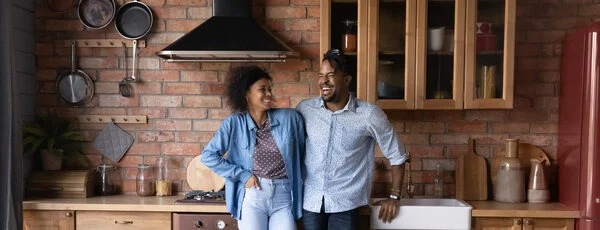Home Equity Improvement Loans and How They Work

Tap into your home’s equity for financial flexibility
How much do you want to borrow?
Checking your options won’t affect your credit
- There are several types of loans for home improvement.
- You may choose from home equity loans, HELOCs, cash-out refinancing, and personal loans.
- The best home improvement loan for you depends on your home equity, credit rating, and the size of your project.
Table of Contents
Renovating or updating a house can be costly and complicated. Fortunately, homeowners can pursue home improvement loans and financing options to afford these projects.
Take the time to investigate different types of home improvement loans and financing strategies, including home equity loans, home equity lines of credit, cash-out refinancing, FHA 203(k) rehab loans, personal loans, and credit cards.
Why Home Improvement Loans Are a Good Idea
Home renovations are usually expensive. Many homeowners lack available savings to fund big projects like a kitchen remodel, room addition, furnace repair, or roof replacement. Thankfully, there are financing opportunities available if you qualify.
“Using available cash savings for a home renovation can prevent you from achieving other financial goals, like investing, saving for retirement, or funding something critical like your child’s college education,” says Joe Cianciolo, CEO/co-founder of HomePace.
The good news is that, unlike borrowing money for short-term indulgences like a wedding, bucket list vacation, or a new car, financing home improvement can increase the resale value of your home and add to your wealth.
Types of home improvement loans using home equity
Eager to learn about the different types of home improvement loans? Read on for suggested options to pursue and details on each.
Home equity loans
A home equity loan is a second mortgage that uses your home as collateral. Most home equity loans have terms of five to 15 years and come with a fixed interest rate, although adjustable-rate choices are possible.
“Home equity loans can be a good solution for people taking on large home improvement projects where the amount needed to complete the project is known,” says Cianciolo. “They are generally available for relatively low fixed rates, and your monthly payments are fixed and predictable – you know exactly how much you will pay monthly.”
On the downside, you get a lump sum when you close on a home equity loan, and you pay interest on the entire amount of the lump sum from Day One – even if it is spent over time. Closing costs can often be high, too, compared to other financing options.
“Also, the amount you can borrow on a home equity loan will be limited by the amount of equity you have earned in your home,” says Leonard Ang, CEO of iPropertyManagement.
Home equity lines of credit (HELOCs)
The HELOC is another second mortgage using your property as collateral. When you close on a HELOC, you don’t receive one lump sum like you would with a home equity loan. Instead, you get the right to tap a credit line secured by your home. HELOCs almost always have an adjustable interest rate (typically based on the prime rate); HELOCs are flexible in that you only borrow the funds when they are needed, and you only accrue interest charges when you have a balance owed.
“With a HELOC, you are essentially borrowing an amount of money less than or equal to the equity you built up in your house. The key difference between a HELOC and a home equity loan is that the former is a line of credit that’s revolving, meaning you can pay it off and then borrow more for your next project without reapplying,” says Carter Seuthe, CEO of Credit Summit.
Among the drawbacks, you may pay more over time if and when your interest rate adjusts. Also, payback periods are shorter for HELOCs versus home equity loans, resulting in potentially higher monthly payments.
Cash-out refinancing
Instead, you could opt to refinance your existing mortgage loan and tap into your home’s available equity by taking cash out at closing.
“A cash-out refinance is a great option for those seeking a new loan amount less than 80% of the loan-to-value of their home,” explains Johnny Macias, managing broker for Colorado Mortgage Connect in Parker, Colorado. “Depending on the amount of cash desired, this loan will give you the amount desired when funding your loan. Plus, you’ll likely lock in a lower interest rate with this option than with a home equity loan or HELOC. And you won’t have to take out a second mortgage or line of credit.”
However, you will have to pay closing costs for a cash-out refinance, which can equal 2% to 5% of your loan amount, depending on your lender. Cash-out refinancing fees can be steep and they apply to the entire loan balance, not just the cash-out. If you pay a 1% charge on a $400,000 loan to get $25,000 of cash-out, that’s a 16% cost.
Cash-out refinancing can be the cheapest option if your existing mortgage balance is small and you’re taking a very large amount of cash-out. Run the numbers before committing because most people are better served with a home equity loan or HELOC.
“Also, a cash-out refi isn’t ideal if you don’t plan to stay in your home for at least a few years, as they can take a long time to pay off and recoup your closing costs,” says Jake Hill, CEO of DebtHammer in Austin, Texas.
FHA 203(k) rehab loans
Seeking to purchase or refinance a fixer-upper? Consider an FHA 203(k) rehab loan, which bundles the cost of your renovation into a refinance or purchase loan. That means you only have to close one loan and make a single payment. Backed by the government, this rehab loan only requires a 3.5% down payment on the property acquisition cost (purchase price plus renovation expense).
Rehab loans take longer to close and have a few more fees. You need to line up a licensed contractor and have an estimate of repairs. The lender commissions an appraisal based on the improved value of the property.
“The interest rate charged for this loan may be a little less than a HELOC, home equity loan, or cash-out refinance,” says Macias. “But this loan will usually require more upfront documents and plans before submission. Your property will need to be inspected, signed off, and approved by your lender, and all work must be completed by a licensed FHA-approved contractor.”
Because the loan amount is based on the cost of improvements, it’s possible to get this kind of home equity loan without existing home equity.
Types of home improvement loans without using home equity
Personal loans without using home equity
Have you considered personal loans for home improvement? A personal loan is an unsecured signature loan. On the plus side, it doesn’t obligate you to use your home as collateral. Additionally, it takes little time to process this type of loan because the lender isn’t appraising your home or evaluating your improvements.
The spread between personal loan and home equity loan rates is fairly narrow for highly qualified borrowers – but much greater for those with less than excellent credit.
“But be aware that you’re almost definitely going to pay higher interest rates for less money on these loans than you would for most of the other options,” Ang cautions.
Credit cards
One strategy you can use in a pinch, especially if you don’t qualify for any of the other financing possibilities, is to charge home improvement costs on your credit card.
“Credit cards can be good options for those who already have established lines of credit. You can also benefit from rewards on the credit card like points earned or frequent flyer miles earned. Obtaining a line of credit large enough for a costly remodel may be difficult, however, without a proven account history with that creditor,” notes Macias.
Seuthe adds that this can be a worthy option if you can get a card that charges no interest for at least a year. “If you make all of your payments on time, this can be the single lowest-interest option for financing a project,” he says.
However, credit cards should be reserved for relatively low-budget projects that you can afford to pay off within a few months. Otherwise, you will likely pay very high interest rates with this option and jeopardize your credit if you can’t pay back your debt punctually.
Best home improvement loans - home equity or personal loans
Curious what the experts recommend as the best home improvement loans? The answer depends on your credit, equity, ability to repay, and goals.
“The best option depends on the size and amount of your project and your ultimate goals with them,” says Hill. “If you are doing major renovations and plan to stay in your home for many years to come, a cash-out refinance may be the best way to go. But if your renovations are more modest, a personal loan could do the trick.”
Ask Ang and he’ll tell you that a HELOC is your best bet.
“If you can qualify for a home equity line of credit, it offers the best combination of security and flexibility for your home improvement needs. It could potentially see you through a few rounds of renovations on a home,” continues Ang.
Macias agrees.
“HELOCs provide the upfront cash needed to complete your home improvement work without having enormous closing cost fees, interest rates, or having to go through a cumbersome process of submitting documents and contractor bids to the lender in order to obtain money,” he says.

Tap into your home’s equity for financial flexibility
How much do you want to borrow?
Checking your options won’t affect your credit
What are the best home improvement loans?
The best home-improvement financing choice for you depends on your creditworthiness, financial goals, and the size, scope, and timeline of your home improvement project. A home equity line of credit offers the most financial flexibility, as you only borrow the money when you need it, and you only begin repaying your debt when you have a balance due. You may pay a lower interest rate with a cash-out refinance or home equity loan, but closing costs could be expensive. A low- or zero-interest credit card is worth considering if you know you can repay what you charge within a short timeframe.
What is a home equity line of credit (HELOC)?
A HELOC is a revolving line of credit that uses your property as collateral. The interest rate is adjustable. You can draw from your line of credit at the time you need it, and you only begin repaying your debt when you have a balance owed. You can pay off what you owe and then borrow more for your next phase or new project without reapplying. You may end up paying more for this financing option due to the adjustable interest rate attached, and you’ll have to pay back your debt in a shorter period than for a cash-out refinance or home equity loan.
What are personal loans for home improvement?
A personal loan is a loan that doesn’t require using your home as collateral – only a signature is typically needed. Qualifying for a personal loan is often easier than for other loans or financing options. However, personal loans commonly charge higher interest rates, and maximum loan amounts are lower than other financing choices.